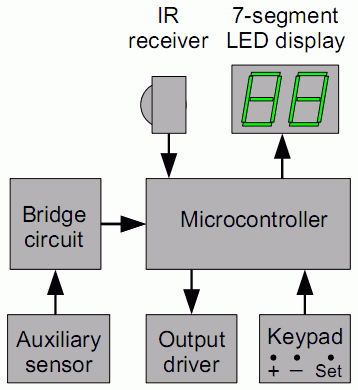Room thermostat
The default application for the IR remote thermometer is transmitting temperature data to a room thermostat, a device cappable of controlling an electrical heater in such a fashion so that the temperature inside a room stays constant. One such thermostat has been developed as a demonstrational device. Nevertheless, as work on the project progressed, designers couldn't resist packing into it quite a few rather intersting functions. This page explaines some of them.

The above diagram explains the internal structure of the room thermostat. As can be seen, current temperature reading is displayed on a two digit 7-segment LED display. The displayed value is updated twice a minute, as soon as new valid temperature data is received from the remote thermometer (transmitter). Update speed is sufficient for the intended application as thermal inertia prevents air temperature inside closed rooms to change too fast.
Thermostat is able to control electrical loads up to 240V / 2kW using the output driver circuit consisting of a small signal NPN transistor and a 6V input relay switch. It is worth noting that the majority of loads which might actually be controlled by this kind of thermostat are simple electrical fans used to blow air over the heating elements, so there is probably no need for the output driver circuit to be as powerfull as this one.
Optimal room temperature can be set by the user via a simple three button keypad, denoted "+", "-" and "Set". At any moment, the temperature can be set to a lower or higher value with 1 Celsius degree resolution by pressing + or - key. The user is able to manually override the automatic regulation by pressing "Set" key which toggles the output driver circuit to a permanently On/Off state. Manual override mode is turned off by pressing briefly either "+" or "-" key.
In addition to setting the absolute temperature value around which the thermostat is supposed to keep the room temperature, it is possible to set the temperature hystheresis i.e. the difference between the lower and the upper temperature threshold values which the device tollerates. For example, if the intended mean temperature is set to +25'C and hystheresis difference to +/- 2'C, the thermostat will turn the output driver circuit on should the temperature fall below 25 - 2 = 23'C, and then turn it off should the temperature reach 25 + 2 = 27'C. Larger hystheresis values lead to less frequent turning of the output circuit and consequently the heating element on and off. This value is easily set by pressing simoultaneously "+" and "-" keys and then setting the desired value by pressing them one at a time. In hystheresis setting mode, the left display digit alternatively blinks the upper and the lower horisontal line while the right digit displays the value set. This mode is exited by pressing briefly the "Set" button.
The thermostat unit is equipped by a local temperature sensor which is used for measuring room temperature in case the remote thermomerer ceases to transmit data. This sensor is of the same type as the one inside the remote unit, but data it provides cannot be considered as precise since it is by default mounted in the near proximity of the heating element. Nevertheless, it enables heating element operation if remote thermometer batteries run out of power or it starts malfunctioning.
The fact than the thermostat part of the remote thermometer-thermostat system inevitably contains a standard IR receiver module led to the idea to utilyse it so that commands from any standard remote transmitter (e.g. TV remote) can be used to operate thermostat functions instead of using kaypad buttons on its housing. This was not that hard to do since a proven IR decoding routine was available as it has already been developed by Eltron for
IR touch dimmer project. By pressing simoultaneously all three kaypad buttons for a few seconds, IR programming mode is entered in which the device expects from 1 to 4 IR commands to be programmed in by the user - each of those keys on the remote control unit which the user wishes to use for commanding the thermostat are supposed to be pressed down twice, one at a time. After that, the thermostat will react to those commands as described in the table below:
| 1. |
Increase mean temperature value by 1'C |
| 2. |
Decrease mean temperature value by 1'C |
| 3. |
Manually toggle output driver circuit to a permanently On/Off state |
| 4. |
Increase/decrease temperature hystheresis by 1'C |
If less than 4 different commands were programmed-in, the thermostat will react to only the first two or three. If only a single command was programmed-in, it alternatively increases/decreases mean temperature value with 1'C step.

 The above diagram explains the internal structure of the room thermostat. As can be seen, current temperature reading is displayed on a two digit 7-segment LED display. The displayed value is updated twice a minute, as soon as new valid temperature data is received from the remote thermometer (transmitter). Update speed is sufficient for the intended application as thermal inertia prevents air temperature inside closed rooms to change too fast.
The above diagram explains the internal structure of the room thermostat. As can be seen, current temperature reading is displayed on a two digit 7-segment LED display. The displayed value is updated twice a minute, as soon as new valid temperature data is received from the remote thermometer (transmitter). Update speed is sufficient for the intended application as thermal inertia prevents air temperature inside closed rooms to change too fast.